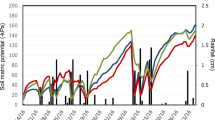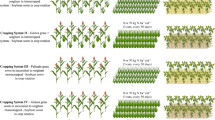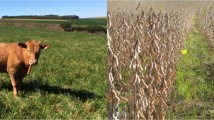Abstract
Yields of groundnut, the traditional grain legume grown in central and southern Cameroon and in much of the humid zone of Central Africa, are generally low. Other food legumes may provide alternatives to groundnut. On-farm experiments examined the relative yields of up to 15 pigeonpea, 10 groundnut, 7 soybean, and 4 cowpea varieties over three growing seasons in four to six rural communities. Soil analytical values and rainfall data from all seasons were used as covariates in the analysis of variance. In the first two trials, variety-within-species interactions were significant (P < 0.0001 and 0.04). Groundnut var. JL-24 yielded 60% more than local groundnuts in the first season of 2000, while soybean var. TGx1838-5E, local cowpea var. `Mefak' and pigeonpea var. ICEAP 00436 outyielded several other varieties of their respective species. Comparing these selected varieties over three seasons, significant species × community and species × season effects (P < 0.0001) were observed. Covariate analysis showed that soybean yields increased with increasing soil Mg saturation and P levels. Groundnut yielded more in the first season of 2000 compared to the second seasons of 1999 and 2000 (average yields of 927 kg ha−1 vs. 422 and 522 kg ha−1, respectively). Improved yields were related to soil exchangeable Ca levels greater than 5 cmol(+) kg−1 in both second seasons, but not during the first season. Cowpea yields were superior in both second seasons. Pigeonpea yields were unrelated to soil factors, showing its wide adaptability to soil conditions. Pigeonpea, which matured in February during the dry season, was severely affected by the early cessation of rains in 2000. In 1999 yields averaged 820 kg ha−1 across communities. The results show that good food legume alternatives to groundnut exist, particularly for second season production. Species can be targeted to communities based on soil properties and season of production.
Similar content being viewed by others
References
Adams F. 1984 Crop response to lime in the Southern United States. In Soil Acidity and Liming. Ed. F. Adams. pp. 211–265. American Society of Agronomy, Madison, Wisconsin, USA.
Ae N, Arihara J, Okada K, Yoshihara T and Johansen C 1990 Phos-phorus uptake by pigeon pea and its role in cropping systems of the Indian subcontinent. Science 248, 477–480.
Atemkeng M F 2000 Grain legume yield and response to soil physio-chemical properties in the humid forest zone of Cameroon. Memoire presented in partial fulfillment of the re-quirements for the award of diplôme d'ingénieur agronome, University of Dschang, Dschang, Cameroon. 67 pp.
Aune J B and Lal R 1997 Agricultural productivity in the tropics and critical limits of properties of Oxisols, Ultisols, and Alfisols. Trop. Agricult. 74, 96–103.
Barnhisel R and Bertsch P 1982 Aluminum. In Methods of Soil Analysis, Part 2, Chemical and Microbiological Properties. Eds. A Page, R Miller and D Keeney. pp. 275–300. American Society of Agronomy, Madison, Wisconsin, USA.
Bledsoe R W, Comer C L and Harris H C 1949 Absorption of radioactive calcium by the peanut fruit. Science 109, 329–330.
Board J E and Cardwell A G 1991 Response of determinate soybean cultivars to low pH soils. Plant Soil 132, 289–292.
Brady N C 1947 The effect of calcium supply and mobility of cal-cium in the plant on peanut fruit filling. Soil Sci. Soc. Am. Proc. 12, 336–341.
Bremner J M and Tabatabai MA 1972 Use of an ammonia electrode for determination of ammonium in Kjeldahl analysis of soils. Comm. Soil Sci. Plant Anal. 3, 159–165.
Büttner U 1996 Soil nutrient management practices of farmers in the humid forest region of South Cameroon. MSc thesis, Institute of Rural Development, Univ. of Goettingen, sGoettingen, Germany. 88 pp.
Carier E F, Fonseca A F, Feldhous I C and Blum J 2001 Root growth and nutrient uptake by soybean as affected by lime and gypsum, under a no-tillage system. Revista Brasileira de Ciencia do Solo 25, 1029–1040.
Clark R B 1984 Physiological aspects of calcium, magnesium, and molybdenum deficiencies in plants. In Soil Acidity and Lim-ing. Ed. F. Adams. pp. 99–170. American Society of Agronomy, Madison, Wisconsin, USA.
Elad R 1999 A 'separate spheres' approach to the agricultural household model. PhD. dissertation, University of Georgia. Athens, Georgia.
Fanwoua J 2001 Effets de la fertilisation azotée et phosphatée ap-pliquées en starter sur la fixation de l'azote et le rendement du soja (Glycine max (L.) Merrill) dans le Sud-Cameroun. Mémoire présenté en vue de l'obtention du diplôme d'ingénieur agronome, University of Dschang, Dschang, Cameroon. 62 pp.
Fox R L, Yost R S, Saidy N A and Kang B T 1985 Nutritional com-plexities associated with pH variables in humid tropical soils. Soil Sci. Soc. Am. J. 49, 1475–1480.
Foy C D, Carter Jr. T E, Duke J A and Devine T E 1993 Correlation of shoot and root growth and its role in selecting for aluminum tolerance in soybean. J. Plant Nutr. 16, 305–325.
Heanes D L 1984 Determination of organic C in soils by an improved chromic acid digestion and spectro-photometric pro-cedure. Comm. Soil Sci. Plant Anal. 15, 1191–1213.
IRA 1990 Filière arachide et recherche arachidière dans la zone humid du Cameroun. Ministère de l'enseignement supérerieur, de l'informatique et de la recherche scientifique, Institute de la Recherche Agronomique.
Lins I D G and Cox F R 1989 Effect of extractant and selected soil properties on predicting the correct phosphorus fertilization of soybean. Soil Sci. Soc. Am. J. 53, 813–816.
Maesen L J G and Somaatmadja S 1992 Plant Resources of South-East Asia (PROSEA). No 1. Pulses. Prosea Foundation, Bogor, Indonesia. 106 pp.
Mandimba G R and Djondo Y M 1996 Nodulation and yields of Arachis hypogaea L. as affected by soil management in the Congo. Biol. Agric. Hort. 12, 339–351.
Mayz de Manzi J, Sim N and Cartwright P M 1983 Cowpea rhizo-bia: variation in acid tolerance and the effects of aluminium and manganese ions. Tropical Grain Legume Bulletin 27, 17–20.
Mehlich M 1984 Mehlich 3 soil test extractant: a modification of the Mehlich 2 extractant. Comm. Soil Sci. Plant Anal. 15, 1409–1416.
Menzies N W and Gillman G P 1997 Chemical characterization of soils of a tropical humid forest zone: A methodology. Soil Sci. Soc. Am. J. 62, 1355–1363.
Mosquera A and Mombiela F 1986 Comparison of three methods for the determination of soil Al in an unbuffered salt extract. Comm. Soil Sci. Plant Anal. 17, 97–113.
Motomizu S, Wakimoto P and Toei K 1983 Spectrophotometric determination of phosphate in river waters with molybdate and malachite green. Analyst (London) 108, 361–367.
Mutsaers H J W 1991 Opportunities for second-season cropping in Southwestern Nigeria. International Institute of Tropical Agri-culture. Ibadan, Nigeria. 28 pp.
Mutsaers H, Mbouémboué P and Boyomo M 1981 Traditional food crop growing in the Yaoundé area (Cameroon). Part II. Crop associations, yields, and fertility aspects. Agro-Ecosystems 6, 289–303.
Nelson D W and Sommers L E 1972 A simple digestion procedure for estimation of total nitrogen in soils and sediments. J. Environ. Qual. 1, 423–425.
Nurlaeny N, Marschner H, and George E 1996 Effects of liming and mycorrhizal colonization on soil phosphate depletion and phosphate uptake by maize (Zea mays L.) and soybean (Glycine max L.) grown in two tropical acid soils. Plant Soil 181, 275–285.
SAS 1989 SAS Stat User's Guide, Version 6, Fourth Edition, Volume 2. Cary NC. SAS Institute Inc. 846 pp.
Shen-RenFang, Ae N and Shen R F 2001 Extraction of P solubiliz-ing active substances from the cell wall of groundnut roots. Plant Soil 228, 243–252.
Simanungkalit R D M, Roughley R J, Hastuti R D, Indrasumunar A and Pratiwi E 1996 Inoculation of soybean with selected strains of Bradyrhizobium japonicum can increase yields on acid soils in Indonesia. Soil Biol. Biochem. 28, 257–259.
Tiki-Manga T and Weise S 1995 ASB 1994 annual report. Mimeo-graph, IITA, Yaounde, Cameroon.
Wendt J W 2002 Groundnut response to ash, phosphorus, lime and tillage in Cameroon. Biol. Agric. Hort. 20, 187–199
Author information
Authors and Affiliations
Rights and permissions
About this article
Cite this article
Wendt, J., Atemkeng, M. Soybean, cowpea, groundnut, and pigeonpea response to soils, rainfall, and cropping season in the forest margins of Cameroon. Plant and Soil 263, 121–132 (2004). https://doi.org/10.1023/B:PLSO.0000047731.35668.e0
Issue Date:
DOI: https://doi.org/10.1023/B:PLSO.0000047731.35668.e0




